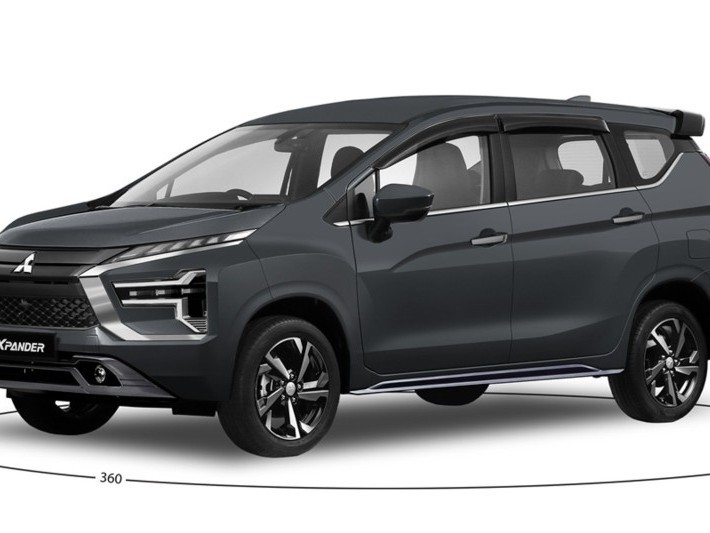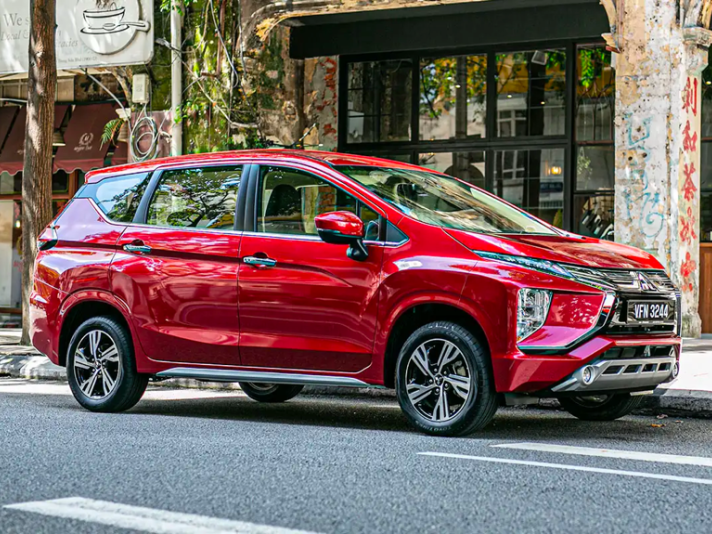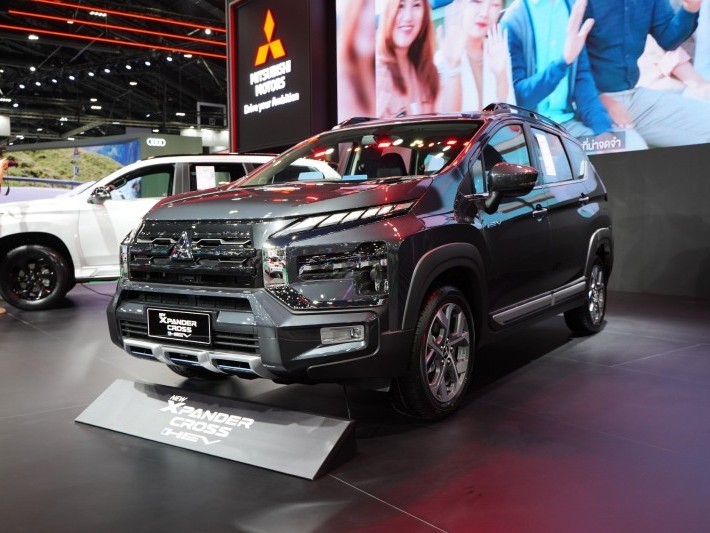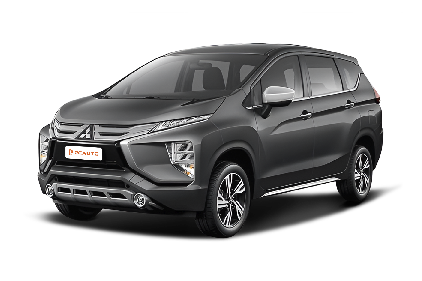Q
mitsubishi xpander 1 liter berapa km
The mileage of Mitsubishi Xpander for 1 liter of gasoline is subject to various factors such as driving habits, road conditions, vehicle load, etc. Generally speaking, under normal driving conditions, it can drive approximately 15 - 20 kilometers. However, it should be noted that this is just an approximate estimation.
Special Disclaimer: This content is published by users and does not represent the views or position of PCauto.
Related Q&A
Q
Is Xpander 2024 3 cylinder?
Based on the current information, the 2024 Mitsubishi Xpander available in the Malaysian market is equipped with a 1.5 - liter MIVEC four - cylinder naturally aspirated engine, not a three - cylinder configuration. This engine delivers 105 horsepower and 141 Nm of torque, paired with either a 5 - speed manual or a 4 - speed automatic transmission. It focuses on providing smoothness and fuel efficiency for the family car market.
The doubts about a three - cylinder engine might stem from the fact that some brands have adopted three - cylinder technology in recent years for emission reduction purposes. However, the Xpander maintains a four - cylinder layout to ensure power stability. It's worth noting that although three - cylinder engines are smaller in size and more fuel - efficient, they usually require more advanced technical tuning for vibration suppression and high - speed performance. In contrast, the four - cylinder structure still has advantages in terms of durability and smoothness.
Malaysian consumers can make their choices according to their own needs when purchasing. If they prioritize low fuel consumption and are open to new technologies, they can look into three - cylinder models from other brands. If they prefer a more mature powertrain, the four - cylinder configuration of the Xpander remains a reliable option. It is recommended to take test drives to experience the differences.
Q
What is the ground clearance of the Xpander 2024?
The 2024 Mitsubishi Xpander has a ground clearance of 205 millimeters. This figure is relatively high among compact MPVs and allows the vehicle to adapt well to Malaysia's diverse road conditions, including urban roads and the rough terrains in the suburbs. The high ground clearance not only improves the vehicle's passability but also reduces the risk of chassis scratches, especially on flooded roads that may occur during the rainy season in Malaysia.
In addition to the ground clearance, the 2024 Xpander is also equipped with an optimized suspension system, which further enhances driving stability and comfort. For Malaysian consumers, this type of high - chassis MPV is very practical. It can meet the needs of family outings and handle complex road conditions.
If you often need to carry passengers or cargo and also pay attention to the vehicle's passability, the 2024 Xpander would be a great choice. Its space performance and practicality are also worth noting.
Q
Is the 2024 Mitsubishi Xpander a MPV or SUV?
The 2024 Mitsubishi Xpander falls into the MPV (Multi-Purpose Vehicle) category rather than the SUV (Sport Utility Vehicle) category. Its original design aim was to meet the needs of family users for spacious interiors and comfortable riding experiences. It features a three - row seat layout and sliding side doors, which are typical characteristics of MPVs. The Xpander has a relatively high ground clearance and crossover - style exterior kits, making it look somewhat like an SUV. However, in essence, it remains an MPV focused on practicality and versatility.
For consumers in Malaysia, the Xpander is an excellent family vehicle. It offers good comfort and convenience, whether for city driving or long - distance trips. The main differences between MPVs and SUVs lie in their body structures and uses. MPVs prioritize passenger space and cargo - loading flexibility, while SUVs emphasize off - road performance and driving visibility. Consumers can choose the appropriate model based on their actual needs.
The Xpander has always been very popular in the Malaysian market because it combines practicality, economy, and reliability, making it a great fit for local road conditions and family - use scenarios.
Q
What is the fuel consumption of the 2024 Mitsubishi Xpander?
The 2024 Mitsubishi Xpander offers a moderate fuel economy. According to official data, its combined fuel consumption is approximately 6.5 to 7.2 liters per 100 kilometers. The exact figure may vary slightly depending on driving habits, road conditions, and vehicle configurations (such as the 2WD or 4WD versions). This model is equipped with a 1.5-liter MIVEC naturally aspirated engine, paired with a 4-speed automatic or 5-speed manual transmission. The power is tuned to meet the practical needs of families.
For Malaysian users, the Xpander's fuel consumption is suitable for daily city commuting and medium - to short - distance trips, especially considering the common traffic congestion in the local area. It is recommended to perform regular maintenance (such as replacing the air filter and spark plugs) to optimize fuel efficiency. In addition, if you want to further reduce fuel consumption, you can try some fuel - saving driving techniques like smooth acceleration and reducing idling time.
Similar models in the same class, such as the Toyota Avanza or Honda BR - V, have a comparable fuel economy. However, the Xpander has an edge in terms of space flexibility and cost - effectiveness, making it a great choice for family users who value practicality.
Q
How to open the hood of Xpander 2024?
To open the hood of the 2024 Mitsubishi Xpander, first, sit in the driver's seat. Locate a handle with a hood icon near the driver's side foot area. Usually, it's located at the lower - left of the steering wheel or on the side of the dashboard. Pull this handle firmly, and you'll hear the sound of the first hood lock releasing. Then, walk to the front of the vehicle, reach your hand into the gap in the center of the front edge of the hood, and you can feel a lever for the secondary safety lock. Push the lever to the right and gently lift the hood to fully open it. It's recommended to ensure the vehicle is turned off and parked on a flat surface during the operation for safety.
It's worth noting that the hood opening methods of Xpander models from different years may vary slightly. The 2024 model uses a double - lock mechanism to prevent the hood from popping open accidentally while driving, which is also the standard safety design for most new cars nowadays. If you have difficulty opening the hood, don't force it. Check if both locks are fully released. Regularly applying lubricant to the lock parts can also keep the mechanism running smoothly. Understanding these details can help car owners better perform basic maintenance tasks such as checking the engine oil and coolant in daily life.
Q
What is the safety rating of the Mitsubishi Xpander 2024?
As of 2024, the safety rating of the Mitsubishi Xpander has not been officially announced by ASEAN NCAP or other major global evaluation institutions (such as Euro NCAP). However, referring to the performance of the 2023 model, the vehicle received a 4-star rating in the ASEAN NCAP test, mainly thanks to its standard basic safety features like dual airbags, ABS anti-lock braking system, and Electronic Stability Control (ESC). For Malaysian consumers, the practicality of the Xpander, such as its 7-seater layout and high ground clearance, is quite popular among family users. However, if you have higher requirements for safety performance, you can pay attention to models in the same class, such as the Toyota Veloz or the Honda BR-V, both of which promote themselves with a 5-star safety rating. It's worth noting that while safety ratings are important, actual driving safety depends more on driving habits and regular maintenance. It is recommended to test-drive the vehicle before purchasing to experience its dynamic performance and to check the convenience of the after-sales service network. Mitsubishi has a relatively well - established dealer system in Malaysia, which provides a guarantee for subsequent maintenance.
Q
Is the Xpander 2024 a hybrid?
The 20204 Xpander is available in a hybrid version. Its gasoline - electric hybrid system consists of a 1.6L four - cylinder naturally aspirated gasoline engine with the code 4A92 paired with an electric motor. The engine has 95 horsepower and 134 Nm of torque. After being paired with the motor, the combined horsepower output reaches 116, and the combined torque is 255 Nm. The transmission system is mated to an e - CVT electronic continuously variable automatic transmission, and it adopts front - wheel drive.
Compared with the regular gasoline version, the hybrid version has some additional blue trim strips on the front bumper and features different two - tone wheels. The rear - wheel braking system has been upgraded from drum brakes to disc brakes. It also offers new suspension tuning, an active cornering control system, and a seven - mode driving selection system.
In terms of the interior, it comes with a newly - designed steering wheel. The instrument panel has been upgraded to an 8 - inch LCD screen, and the shift lever and driving - mode selection lever also feature brand - new designs, which can bring a different driving and riding experience.
Q
How to start Xpander 2024?
Starting the 2024 Mitsubishi Xpander is a breeze. First, make sure the vehicle is in P (Park) mode. Then, press the brake pedal and push the start button to fire up the engine. If it's equipped with a traditional key - start system, insert the key into the ignition switch and turn it clockwise to the start position. This car comes with an intelligent key system. As long as the key is inside the car, you can start it without inserting the key, which is extremely convenient.
After starting, it's advisable to wait a moment for the engine to complete its self - check before shifting into D (Drive) mode to start driving. The 2024 Xpander also features an ECO driving mode, which can be switched via a button on the center console. This mode helps improve fuel economy, making it especially suitable for the frequent stop - and - go traffic in Malaysian cities. Additionally, the idle start - stop function automatically shuts off the engine when waiting at traffic lights to save fuel and restarts immediately when you release the brake. If you don't need this function, you can turn it off manually.
As a 7 - seater MPV, the 2024 Xpander is very popular in Malaysia. Its spacious interior and practical configurations make it a great choice for families. The 1.5L MIVEC engine strikes a good balance between power and fuel efficiency, and its maintenance cost is relatively low. It's a model carefully crafted by Mitsubishi for the Southeast Asian market.
Q
How many seaters is Xpander 2024?
The 2024 Mitsubishi Xpander is a highly popular 7-seater MPV model in the Malaysian market. It features a 2+3+2 seating layout, which is suitable for family users or scenarios where multiple passengers need to be accommodated. The second-row seats can be adjusted by sliding forward and backward to enhance flexibility, while the third-row seats are suitable for short trips or for children.
This model continues the practical design of the Xpander series, such as a relatively high ground clearance (205mm) and a compact body size, which takes into account both urban driving and mild off-road performance. In terms of power, it is equipped with a 1.5L MIVEC naturally aspirated gasoline engine (105PS/141Nm), paired with a 4AT or 5MT transmission, focusing on fuel economy.
It's worth noting that competing models in the same class, such as the Toyota Avanza/Perodua Alza, also adopt a 7-seater layout. However, the Xpander differentiates itself with its more angular exterior design and Mitsubishi's Dynamic Shield front - end styling. The basic trunk volume is 185L, which can be expanded to 1600L when the third - row seats are folded, meeting the multi - purpose needs of Malaysian users.
It is recommended that you visit an authorized showroom to experience the third - row space in person before purchasing a car. In particular, you need to consider the comfort of adult long - distance travel. At the same time, you can compare the configurations and prices of competing models in the same class, such as the Honda BR - V or Nissan Livina.
Q
How much is Mitsubishi Xpander Malaysia 2024?
The 2024 Mitsubishi Xpander is available in two models in Malaysia. The Xpander is priced at RM 99,980, and the Xpander Plus is priced at RM 109,980 (the above prices are excluding insurance). This 7-seater MPV not only has an upgraded exterior but also an improved interior configuration. It's equipped with a 1.5-liter MIVEC naturally aspirated engine, which emphasizes reliability and fuel economy, with a fuel consumption of about 7.5L per 100 kilometers, making it suitable for daily city commuting and family trips. It has a length of 4,595mm, a width of 1,750mm, a height of 1,750mm, a wheelbase of 2,775mm, and a ground clearance of 205mm, enabling it to perform well on different road conditions. As the high - end version, the Xpander Plus comes with additional features such as leather seats, a wireless phone charging panel, a 360° panoramic camera, and front and rear dash cams.
Latest Q&A
Q
How to check the oil level on a 2018 Volvo XC90?
To check the engine oil level of the 2018 Volvo XC90, first make sure the vehicle is parked on a level surface and turn off the engine for at least 10 minutes to allow the oil to drain back into the oil pan. Then open the hood and find the oil dipstick, usually a yellow or orange pull - ring. Pull it out, wipe it clean with a clean cloth, re - insert it, and then pull it out again. Check if the oil mark is between the "MIN" and "MAX" markings on the dipstick. If it's below the "MIN" mark, you need to add 0W - 20 engine oil that meets Volvo's certification.
Given the hot and humid climate in Malaysia, it's recommended to regularly check the condition of the engine oil, as high temperatures can accelerate oil oxidation. Also, be aware of the electronic oil gauge system equipped in the Volvo XC90. You can view the digital oil level display through the vehicle information menu on the central control screen, which is more accurate than the traditional oil dipstick.
During daily maintenance, besides paying attention to the oil level, also note the color of the oil. If you find it has turned black or contains metal debris, replace it immediately. It's advisable to follow the manufacturer's maintenance cycle of every 10,000 kilometers or 12 months. Using the synthetic oil recommended by the factory can better protect the turbocharged engine and maintain good lubrication performance even in Malaysia's mountainous terrain.
Q
How to check tire pressure on 2018 Volvo XC90?
To check the tire pressure of the 2018 Volvo XC90, first make sure the tires are cold (the vehicle has been parked for at least 3 hours or driven for no more than 2 kilometers). Then, use a digital tire pressure gauge or the tire pressure detection equipment at a gas station/repair shop. Unscrew the tire valve cap, align the tire pressure gauge with the valve stem and press it firmly, and read the displayed tire pressure value. Compare it with the vehicle's recommended value (usually indicated on the driver's side door frame label, inside the fuel tank cap, or in the user manual. The standard tire pressure for the XC90 is approximately 230 - 250 kPa). If the tire pressure is insufficient, use an air pump to inflate the tires to the recommended value. If it's too high, press the center of the valve stem to release air. In the hot climate of Malaysia, the tire pressure may rise slightly due to high temperatures, but there's no need to deliberately release air because the vehicle's recommended value already takes temperature changes into account. Checking the tire pressure once a month regularly can ensure driving safety and fuel efficiency. At the same time, it's recommended to check the spare tire pressure (if equipped), and note that abnormal tire pressure may cause uneven tire wear or a decline in handling performance. If the tire pressure warning light appears on the dashboard, it needs to be dealt with immediately.
Q
What is the fuel economy of a 2018 Volvo XC90?
The 2018 Volvo XC90 comes in versions such as the T5 and the T8 Twin Engine Inscription. The official combined fuel consumption of the T5 version is 7.9L per 100km, while that of the T8 Twin Engine Inscription version is 2.1L per 100km. However, the actual fuel economy can be affected by multiple factors.
In terms of driving habits, aggressive driving styles like rapid acceleration and sudden braking can increase fuel consumption. On the contrary, good habits such as smooth starts and constant - speed driving can help reduce fuel consumption. Regarding road conditions, in congested urban areas where vehicles frequently start and stop, fuel consumption will go up. On the other hand, on highways where vehicles can maintain a stable high - speed, fuel consumption is usually lower.
If the vehicle is overloaded, for example, when it is often full of passengers or carrying a large amount of cargo, the engine has to output more power, which also leads to an increase in fuel consumption. In addition, good vehicle maintenance, such as regular servicing and maintaining proper tire pressure, is beneficial for keeping fuel consumption low.
Q
How to check the oil in a 2018 Volvo XC90?
To check the engine oil level of the 2018 Volvo XC90, first make sure the vehicle is parked on a level surface and turn off the engine for at least 10 minutes to let the oil drain back into the oil pan. Then, open the engine compartment and find the orange or yellow dipstick. Pull it out, wipe it clean, re - insert it, and then pull it out again. Check if the oil level is between the "MIN" and "MAX" marks. If it's below the "MIN" mark, you need to add 0W - 20 full - synthetic engine oil that meets the manufacturer's specifications.
It's worth noting that in the tropical climate of Malaysia, it's recommended to regularly check the condition of the engine oil, as high temperatures may accelerate oil oxidation. Meanwhile, the electronic oil gauge of the XC90 can be viewed through the center console screen, but checking with the traditional dipstick is still a reliable method.
For turbocharged engines, maintaining an appropriate oil level is especially important, as the oil not only lubricates but also cools the turbo components. It's recommended to check the oil level every 5,000 kilometers or every 3 months. You should also confirm the oil condition before long - distance driving, which helps to extend the engine's lifespan and maintain optimal performance.
Q
What model XC90 has massage seats?
In the Malaysian market, the Volvo XC90 models that offer massage seats are mainly the high - end versions, such as the T8 Inscription and R - Design models. The front seats of these models are usually equipped with multi - way power adjustment, heating, ventilation, and massage functions, which are especially suitable for relieving fatigue during long - distance driving. The massage seats in the XC90 typically offer a variety of modes and intensity options, and can provide soothing presses on areas like the waist and back, enhancing the seating comfort.
In addition to the massage seats, the high - end XC90 models are also equipped with other luxury features, such as the Bowers & Wilkins sound system, four - zone automatic climate control, and advanced driver assistance systems, which further enhance the overall driving and riding experience. For Malaysian consumers, choosing these high - end models not only allows them to enjoy a more comfortable ride but also enables them to experience Volvo's leading technologies in safety and technology, such as the City Safety urban safety system and the Pilot Assist pilot - assist system. These features are particularly useful in Malaysia's ever - changing traffic environment.
View MoreRelated News

Mitsubishi Xpander On-Road Price: The Complete Pre-Purchase Guide
JamesApr 9, 2025

Mitsubishi Xpander Redesign: 4AT+1.5L Power Dated, Only 2 Safety Airbags!
JohnSep 24, 2024

Mitsubishi Xpander: Priced at RM 100,980, a perfect combination of comfort, spaciousness and fashion
LienMay 30, 2024

Bangkok Motor Show: MITSUBISHI XPANDER CROSS priced at 946,000 Thai Baht
Kevin WongMar 26, 2024

Mitsubishi brings Xpander and Xpander Cross HEV models to 2024 Bangkok International Motor Show
AshleyMar 18, 2024
View More


















Pros
Cons